List of map projections
Appearance
(Redirected from List of Map Projections)
This is a summary of map projections that have articles of their own on Wikipedia or that are otherwise notable. Because there is no limit to the number of possible map projections,[1] there can be no comprehensive list.
Table of projections
[edit]| Year | Projection | Image | Type | Properties | Creator | Notes |
|---|---|---|---|---|---|---|
| c. 120 | Equirectangular = equidistant cylindrical = rectangular = la carte parallélogrammatique |

|
Cylindrical | Equidistant | Marinus of Tyre | Simplest geometry; distances along meridians are conserved. Plate carrée: special case having the equator as the standard parallel. |
| 1745 | Cassini = Cassini–Soldner |
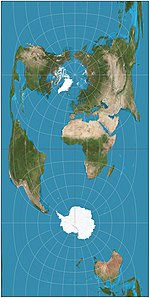
|
Cylindrical | Equidistant | César-François Cassini de Thury | Transverse of equirectangular projection; distances along central meridian are conserved. Distances perpendicular to central meridian are preserved. |
| 1569 | Mercator = Wright |

|
Cylindrical | Conformal | Gerardus Mercator | Lines of constant bearing (rhumb lines) are straight, aiding navigation. Areas inflate with latitude, becoming so extreme that the map cannot show the poles. |
| 2005 | Web Mercator | 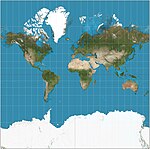
|
Cylindrical | Compromise | Variant of Mercator that ignores Earth's ellipticity for fast calculation, and clips latitudes to ~85.05° for square presentation. De facto standard for Web mapping applications. | |
| 1822 | Gauss–Krüger = Gauss conformal = (ellipsoidal) transverse Mercator |

|
Cylindrical | Conformal | Carl Friedrich Gauss | This transverse, ellipsoidal form of the Mercator is finite, unlike the equatorial Mercator. Forms the basis of the Universal Transverse Mercator coordinate system. |
| 1922 | Roussilhe oblique stereographic | 
|
Henri Roussilhe | |||
| 1903 | Hotine oblique Mercator | 
|
Cylindrical | Conformal | M. Rosenmund, J. Laborde, Martin Hotine | |
| 1855 | Gall stereographic |
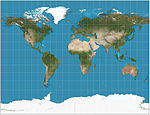
|
Cylindrical | Compromise | James Gall | Intended to resemble the Mercator while also displaying the poles. Standard parallels at 45°N/S. |
| 1942 | Miller = Miller cylindrical |

|
Cylindrical | Compromise | Osborn Maitland Miller | Intended to resemble the Mercator while also displaying the poles. |
| 1772 | Lambert cylindrical equal-area | Cylindrical | Equal-area | Johann Heinrich Lambert | Cylindrical equal-area projection with standard parallel at the equator and an aspect ratio of π (3.14). | |
| 1910 | Behrmann | 
|
Cylindrical | Equal-area | Walter Behrmann | Cylindrical equal-area projection with standard parallels at 30°N/S and an aspect ratio of (3/4)π ≈ 2.356. |
| 2002 | Hobo–Dyer | 
|
Cylindrical | Equal-area | Mick Dyer | Cylindrical equal-area projection with standard parallels at 37.5°N/S and an aspect ratio of 1.977. Similar are Trystan Edwards with standard parallels at 37.4° and Smyth equal surface (=Craster rectangular) with standard parallels around 37.07°. |
| 1855 | Gall–Peters = Gall orthographic = Peters |

|
Cylindrical | Equal-area | James Gall | Cylindrical equal-area projection with standard parallels at 45°N/S and an aspect ratio of π/2 ≈ 1.571. Similar is Balthasart with standard parallels at 50°N/S and Tobler’s world in a square with standard parallels around 55.66°N/S. |
| c. 1850 | Central cylindrical | 
|
Cylindrical | Perspective | (unknown) | Practically unused in cartography because of severe polar distortion, but popular in panoramic photography, especially for architectural scenes. |
| c. 1600 | Sinusoidal = Sanson–Flamsteed = Mercator equal-area |

|
Pseudocylindrical | Equal-area, equidistant | (Several; first is unknown) | Meridians are sinusoids; parallels are equally spaced. Aspect ratio of 2:1. Distances along parallels are conserved. |
| 1805 | Mollweide = elliptical = Babinet = homolographic |

|
Pseudocylindrical | Equal-area | Karl Brandan Mollweide | Meridians are ellipses. |
| 1953 | Sinu-Mollweide | 
|
Pseudocylindrical | Equal-area | Allen K. Philbrick | An oblique combination of the sinusoidal and Mollweide projections. |
| 1906 | Eckert II | 
|
Pseudocylindrical | Equal-area | Max Eckert-Greifendorff | |
| 1906 | Eckert IV | 
|
Pseudocylindrical | Equal-area | Max Eckert-Greifendorff | Parallels are unequal in spacing and scale; outer meridians are semicircles; other meridians are semiellipses. |
| 1906 | Eckert VI | 
|
Pseudocylindrical | Equal-area | Max Eckert-Greifendorff | Parallels are unequal in spacing and scale; meridians are half-period sinusoids. |
| 1540 | Ortelius oval | 
|
Pseudocylindrical | Compromise | Battista Agnese |
Meridians are circular.[2] |
| 1923 | Goode homolosine | 
|
Pseudocylindrical | Equal-area | John Paul Goode | Hybrid of Sinusoidal and Mollweide projections. Usually used in interrupted form. |
| 1939 | Kavrayskiy VII | 
|
Pseudocylindrical | Compromise | Vladimir V. Kavrayskiy | Evenly spaced parallels. Equivalent to Wagner VI horizontally compressed by a factor of . |
| 1963 | Robinson | 
|
Pseudocylindrical | Compromise | Arthur H. Robinson | Computed by interpolation of tabulated values. Used by Rand McNally since inception and used by NGS in 1988–1998. |
| 2018 | Equal Earth | 
|
Pseudocylindrical | Equal-area | Bojan Šavrič, Tom Patterson, Bernhard Jenny | Inspired by the Robinson projection, but retains the relative size of areas. |
| 2011 | Natural Earth | 
|
Pseudocylindrical | Compromise | Tom Patterson | Originally by interpolation of tabulated values. Now has a polynomial. |
| 1973 | Tobler hyperelliptical | 
|
Pseudocylindrical | Equal-area | Waldo R. Tobler | A family of map projections that includes as special cases Mollweide projection, Collignon projection, and the various cylindrical equal-area projections. |
| 1932 | Wagner VI | 
|
Pseudocylindrical | Compromise | K. H. Wagner | Equivalent to Kavrayskiy VII vertically compressed by a factor of . |
| c. 1865 | Collignon | Pseudocylindrical | Equal-area | Édouard Collignon | Depending on configuration, the projection also may map the sphere to a single diamond or a pair of squares. | |
| 1997 | HEALPix | 
|
Pseudocylindrical | Equal-area | Krzysztof M. Górski | Hybrid of Collignon + Lambert cylindrical equal-area. |
| 1929 | Boggs eumorphic | 
|
Pseudocylindrical | Equal-area | Samuel Whittemore Boggs | The equal-area projection that results from average of sinusoidal and Mollweide y-coordinates and thereby constraining the x coordinate. |
| 1929 | Craster parabolic =Putniņš P4 |

|
Pseudocylindrical | Equal-area | John Craster | Meridians are parabolas. Standard parallels at 36°46′N/S; parallels are unequal in spacing and scale; 2:1 aspect. |
| 1949 | McBryde–Thomas flat-pole quartic = McBryde–Thomas #4 |

|
Pseudocylindrical | Equal-area | Felix W. McBryde, Paul Thomas | Standard parallels at 33°45′N/S; parallels are unequal in spacing and scale; meridians are fourth-order curves. Distortion-free only where the standard parallels intersect the central meridian. |
| 1937
1944 |
Quartic authalic | 
|
Pseudocylindrical | Equal-area | Karl Siemon | Parallels are unequal in spacing and scale. No distortion along the equator. Meridians are fourth-order curves. |
| 1965 | The Times | 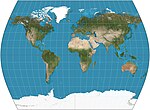
|
Pseudocylindrical | Compromise | John Muir | Standard parallels 45°N/S. Parallels based on Gall stereographic, but with curved meridians. Developed for Bartholomew Ltd., The Times Atlas. |
| 1935
1966 |
Loximuthal | 
|
Pseudocylindrical | Compromise | Karl Siemon | From the designated centre, lines of constant bearing (rhumb lines/loxodromes) are straight and have the correct length. Generally asymmetric about the equator. |
| 1889 | Aitoff | 
|
Pseudoazimuthal | Compromise | David A. Aitoff | Stretching of modified equatorial azimuthal equidistant map. Boundary is 2:1 ellipse. Largely superseded by Hammer. |
| 1892 | Hammer = Hammer–Aitoff variations: Briesemeister; Nordic |

|
Pseudoazimuthal | Equal-area | Ernst Hammer | Modified from azimuthal equal-area equatorial map. Boundary is 2:1 ellipse. Variants are oblique versions, centred on 45°N. |
| 1994 | Strebe 1995 | 
|
Pseudoazimuthal | Equal-area | Daniel "daan" Strebe | Formulated by using other equal-area map projections as transformations. |
| 1921 | Winkel tripel | 
|
Pseudoazimuthal | Compromise | Oswald Winkel | Arithmetic mean of the equirectangular projection and the Aitoff projection. Standard world projection for the NGS since 1998. |
| 1904 | Van der Grinten | 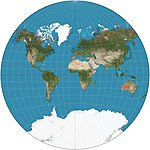
|
Pseudoconic | Compromise | Alphons J. van der Grinten | Boundary is a circle. All parallels and meridians are circular arcs. Usually clipped near 80°N/S. Standard world projection of the NGS in 1922–1988. |
| c. 150 | Equidistant conic = simple conic |
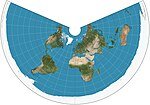
|
Conic | Equidistant | Based on Ptolemy's 1st Projection | Distances along meridians are conserved, as is distance along one or two standard parallels.[3] |
| 1772 | Lambert conformal conic | 
|
Conic | Conformal | Johann Heinrich Lambert | Used in aviation charts. |
| 1805 | Albers conic | 
|
Conic | Equal-area | Heinrich C. Albers | Two standard parallels with low distortion between them. |
| c. 1500 | Werner | 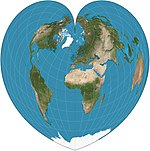
|
Pseudoconical | Equal-area, equidistant | Johannes Stabius | Parallels are equally spaced concentric circular arcs. Distances from the North Pole are correct as are the curved distances along parallels and distances along central meridian. |
| 1511 | Bonne | 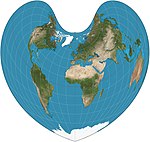
|
Pseudoconical | Equal-area, equidistant | Bernardus Sylvanus | Parallels are equally spaced concentric circular arcs and standard lines. Appearance depends on reference parallel, but cordiform in all but the limiting case. General case of both Werner and sinusoidal. |
| 2003 | Bottomley | 
|
Pseudoconical | Equal-area | Henry Bottomley | Alternative to the Bonne projection with simpler overall shape Parallels are elliptical arcs |
| c. 1820 | American polyconic | 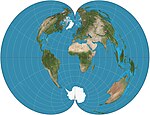
|
Pseudoconical | Compromise | Ferdinand Rudolph Hassler | Distances along the parallels are preserved as are distances along the central meridian. |
| c. 1853 | Rectangular polyconic | 
|
Pseudoconical | Compromise | United States Coast Survey | Latitude along which scale is correct can be chosen. Parallels meet meridians at right angles. |
| 1963 | Latitudinally equal-differential polyconic | Pseudoconical | Compromise | China State Bureau of Surveying and Mapping | Polyconic: parallels are non-concentric arcs of circles. | |
| c. 1000 | Nicolosi globular | 
|
Pseudoconical[4] | Compromise | Abū Rayḥān al-Bīrūnī; reinvented by Giovanni Battista Nicolosi, 1660.[1]: 14 | |
| c. 1000 | Azimuthal equidistant =Postel =zenithal equidistant |
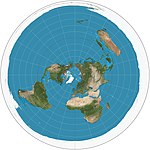
|
Azimuthal | Equidistant | Abū Rayḥān al-Bīrūnī | Distances from center are conserved. Used as the emblem of the United Nations, extending to 60° S. |
| c. 580 BC | Gnomonic | 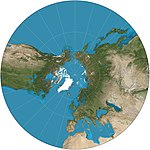
|
Azimuthal | Gnomonic | Thales (possibly) | All great circles map to straight lines. Extreme distortion far from the center. Shows less than one hemisphere. |
| 1772 | Lambert azimuthal equal-area | 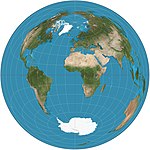
|
Azimuthal | Equal-area | Johann Heinrich Lambert | The straight-line distance between the central point on the map to any other point is the same as the straight-line 3D distance through the globe between the two points. |
| c. 150 BC | Stereographic | 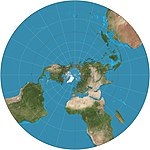
|
Azimuthal | Conformal | Hipparchos* | Map is infinite in extent with outer hemisphere inflating severely, so it is often used as two hemispheres. Maps all small circles to circles, which is useful for planetary mapping to preserve the shapes of craters. |
| c. 150 BC | Orthographic | 
|
Azimuthal | Perspective | Hipparchos* | View from an infinite distance. |
| 1740 | Vertical perspective | 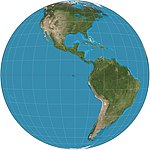
|
Azimuthal | Perspective | Matthias Seutter* | View from a finite distance. Can only display less than a hemisphere. |
| 1919 | Two-point equidistant | 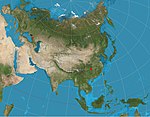
|
Azimuthal | Equidistant | Hans Maurer | Two "control points" can be almost arbitrarily chosen. The two straight-line distances from any point on the map to the two control points are correct. |
| 2021 | Gott, Goldberg and Vanderbei’s |  |
Azimuthal | Equidistant | J. Richard Gott, Dave Goldberg and Robert J. Vanderbei | Gott, Goldberg and Vanderbei’s double-sided disk map was designed to minimize all six types of map distortions. Not properly "a" map projection because it is on two surfaces instead of one, it consists of two hemispheric equidistant azimuthal projections back-to-back.[5][6][7] |
| 1879 | Peirce quincuncial | 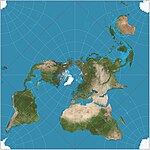
|
Other | Conformal | Charles Sanders Peirce | Tessellates. Can be tiled continuously on a plane, with edge-crossings matching except for four singular points per tile. |
| 1887 | Guyou hemisphere-in-a-square projection | 
|
Other | Conformal | Émile Guyou | Tessellates. |
| 1925 | Adams hemisphere-in-a-square projection | 
|
Other | Conformal | Oscar S. Adams | |
| 1965 | Lee conformal world on a tetrahedron | 
|
Polyhedral | Conformal | Laurence Patrick Lee | Projects the globe onto a regular tetrahedron. Tessellates. |
| 1514 | Octant projection | 
|
Polyhedral | Compromise | Leonardo da Vinci | Projects the globe onto eight octants (Reuleaux triangles) with no meridians and no parallels. |
| 1909 | Cahill's butterfly map | 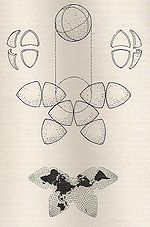
|
Polyhedral | Compromise | Bernard Joseph Stanislaus Cahill | Projects the globe onto an octahedron with symmetrical components and contiguous landmasses that may be displayed in various arrangements. |
| 1975 | Cahill–Keyes projection | 
|
Polyhedral | Compromise | Gene Keyes | Projects the globe onto a truncated octahedron with symmetrical components and contiguous land masses that may be displayed in various arrangements. |
| 1996 | Waterman butterfly projection | 
|
Polyhedral | Compromise | Steve Waterman | Projects the globe onto a truncated octahedron with symmetrical components and contiguous land masses that may be displayed in various arrangements. |
| 1973 | Quadrilateralized spherical cube | Polyhedral | Equal-area | F. Kenneth Chan, E. M. O'Neill | ||
| 1943 | Dymaxion map | 
|
Polyhedral | Compromise | Buckminster Fuller | Also known as a Fuller Projection. |
| 1999 | AuthaGraph projection | 
|
Polyhedral | Compromise | Hajime Narukawa | Approximately equal-area. Tessellates. |
| 2008 | Myriahedral projections | Polyhedral | Equal-area | Jarke J. van Wijk | Projects the globe onto a myriahedron: a polyhedron with a very large number of faces.[8][9] | |
| 1909 | Craig retroazimuthal = Mecca |

|
Retroazimuthal | Compromise | James Ireland Craig | |
| 1910 | Hammer retroazimuthal, front hemisphere | 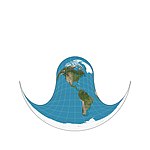
|
Retroazimuthal | Ernst Hammer | ||
| 1910 | Hammer retroazimuthal, back hemisphere | 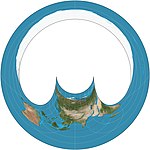
|
Retroazimuthal | Ernst Hammer | ||
| 1833 | Littrow | 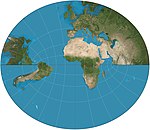
|
Retroazimuthal | Conformal | Joseph Johann Littrow | On equatorial aspect it shows a hemisphere except for poles. |
| 1943 | Armadillo | 
|
Other | Compromise | Erwin Raisz | |
| 1982 | GS50 | 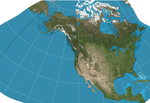
|
Other | Conformal | John P. Snyder | Designed specifically to minimize distortion when used to display all 50 U.S. states. |
| 1941 | Wagner VII = Hammer-Wagner |

|
Pseudoazimuthal | Equal-area | K. H. Wagner | |
| 1946 | Chamberlin trimetric projection | 
|
Other | Compromise | Wellman Chamberlin | Many National Geographic Society maps of single continents use this projection. |
| 1948 | Atlantis = Transverse Mollweide |

|
Pseudocylindrical | Equal-area | John Bartholomew | Oblique version of Mollweide |
| 1953 | Bertin = Bertin-Rivière = Bertin 1953 |

|
Other | Compromise | Jacques Bertin | Projection in which the compromise is no longer homogeneous but instead is modified for a larger deformation of the oceans, to achieve lesser deformation of the continents. Commonly used for French geopolitical maps.[10] |
| 2002 | Hao projection | 
|
Pseudoconical | Compromise | Hao Xiaoguang | Known as "plane terrestrial globe",[11] it was adopted by the People's Liberation Army for the official military maps and China’s State Oceanic Administration for polar expeditions.[12][13] |
| 1879 | Wiechel projection | 
|
Pseudoazimuthal | Equal-area | William H. Wiechel | In its polar version, meridians form a pinwheel |
*The first known popularizer/user and not necessarily the creator.
Key
[edit]Type of projection surface
[edit]- Cylindrical
- In normal aspect, these map regularly-spaced meridians to equally spaced vertical lines, and parallels to horizontal lines.
- Pseudocylindrical
- In normal aspect, these map the central meridian and parallels as straight lines. Other meridians are curves (or possibly straight from pole to equator), regularly spaced along parallels.
- Conic
- In normal aspect, conic (or conical) projections map meridians as straight lines, and parallels as arcs of circles.
- Pseudoconical
- In normal aspect, pseudoconical projections represent the central meridian as a straight line, other meridians as complex curves, and parallels as circular arcs.
- Azimuthal
- In standard presentation, azimuthal projections map meridians as straight lines and parallels as complete, concentric circles. They are radially symmetrical. In any presentation (or aspect), they preserve directions from the center point. This means great circles through the central point are represented by straight lines on the map.
- Pseudoazimuthal
- In normal aspect, pseudoazimuthal projections map the equator and central meridian to perpendicular, intersecting straight lines. They map parallels to complex curves bowing away from the equator, and meridians to complex curves bowing in toward the central meridian. Listed here after pseudocylindrical as generally similar to them in shape and purpose.
- Other
- Typically calculated from formula, and not based on a particular projection
- Polyhedral maps
- Polyhedral maps can be folded up into a polyhedral approximation to the sphere, using particular projection to map each face with low distortion.
Properties
[edit]- Conformal
- Preserves angles locally, implying that local shapes are not distorted and that local scale is constant in all directions from any chosen point.
- Equal-area
- Area measure is conserved everywhere.
- Compromise
- Neither conformal nor equal-area, but a balance intended to reduce overall distortion.
- Equidistant
- All distances from one (or two) points are correct. Other equidistant properties are mentioned in the notes.
- Gnomonic
- All great circles are straight lines.
- Retroazimuthal
- Direction to a fixed location B (by the shortest route) corresponds to the direction on the map from A to B.
- Perspective
- Can be constructed by light shining through a globe onto a developable surface.
See also
[edit]Notes
[edit]- ^ a b Snyder, John P. (1993). Flattening the Earth: Two Thousand Years of Map Projections. University of Chicago Press. p. 1. ISBN 0-226-76746-9.
- ^ Donald Fenna (2006). Cartographic Science: A Compendium of Map Projections, with Derivations. CRC Press. p. 249. ISBN 978-0-8493-8169-0.
- ^ Furuti, Carlos A. "Conic Projections: Equidistant Conic Projections". Archived from the original on November 30, 2012. Retrieved February 11, 2020.
- ^ ""Nicolosi Globular projection"" (PDF). Archived (PDF) from the original on 2016-04-29. Retrieved 2016-09-18.
- ^ "New Earth Map Projection". vanderbei.princeton.edu. Retrieved 2023-04-27.
- ^ Fuller-Wright, Liz. "Princeton astrophysicists re-imagine world map, designing a less distorted, 'radically different' way to see the world". Princeton University. Archived from the original on 2022-07-13. Retrieved 2022-07-13.
- ^ Gott III, J. Richard; Goldberg, David M.; Vanderbei, Robert J. (2021-02-15). "Flat Maps that improve on the Winkel Tripel". arXiv:2102.08176 [astro-ph.IM].
- ^ Jarke J. van Wijk. "Unfolding the Earth: Myriahedral Projections". Archived from the original on 2020-06-20. Retrieved 2011-03-08.
- ^ Carlos A. Furuti. "Interrupted Maps: Myriahedral Maps". Archived from the original on 2020-01-17. Retrieved 2011-11-03.
- ^ Rivière, Philippe (October 1, 2017). "Bertin Projection (1953)". visionscarto. Archived from the original on January 27, 2020. Retrieved January 27, 2020.
- ^ Hao, Xiaoguang; Xue, Huaiping. "Generalized Equip-Difference Parallel Polyconical Projection Method for the Global Map" (PDF). Archived (PDF) from the original on February 9, 2023. Retrieved February 14, 2023.
- ^ Alexeeva, Olga; Lasserre, Frédéric (October 20, 2022). "Le concept de troisième pôle: cartes et représentations polaires de la Chine". Géoconfluences (in French). Archived from the original on February 14, 2023. Retrieved February 14, 2023.
- ^ Vriesema, Jochem (April 7, 2021). "Arctic geopolitics: China's remapping of the world". Clingendael Spectator. The Hague: Clingendael. Archived from the original on February 14, 2023. Retrieved February 14, 2023.
Further reading
[edit]- Snyder, John P. (1987). Map projections – A working manual (PDF). U.S. Geological Survey Professional Paper. Vol. 1395. Washington, D.C.: U.S. Government Printing Office. doi:10.3133/pp1395. Retrieved 2019-02-18.
- Snyder, John P.; Voxland, Philip M. (1989). An Album of Map Projections (PDF). U.S. Geological Survey Professional Paper. Vol. 1453. Washington, D.C.: U.S. Government Printing Office. doi:10.3133/pp1453. Retrieved 2019-02-18.

